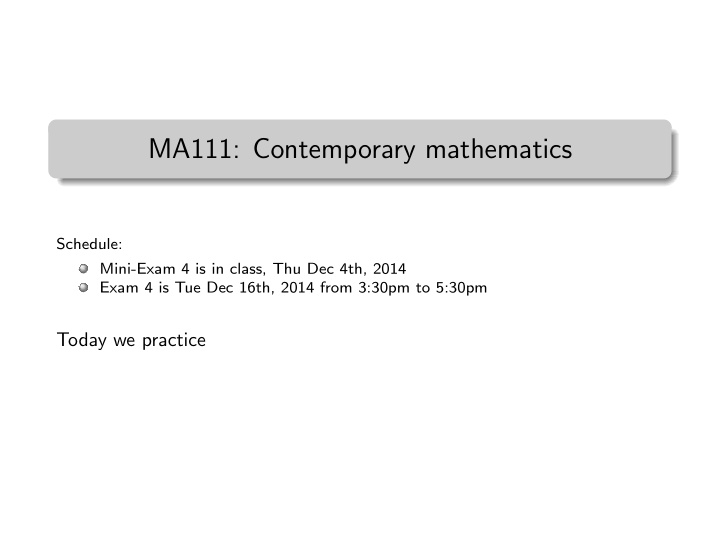



MA111: Contemporary mathematics Schedule: Mini-Exam 4 is in class, Thu Dec 4th, 2014 Exam 4 is Tue Dec 16th, 2014 from 3:30pm to 5:30pm Today we practice
Crawford’s Emergency Gift Todo List Let’s work out an example: Task Duration Need to finish first M: Go to mall 30 min Shovel driveway, research R: Research gift ideas 20 min Nothing D: Shovel driveway 15 min Nothing W: Select wrapping paper 20 min Go to mall 1: Get gifts from first store 20 min Go to mall 2: Get gifts from second store 20 min Go to mall C: Get gift certificate 5 min Research gift ideas H: Go home 30 min Wrapping paper, first store, second store P: Wrap presents 20 min Go home S: Wear grandma’s favorite sweater 2 min Nothing G: Go to grandma’s house 20 min Wrap presents, Sweater T: Place gifts under tree 2 min Go to grandma’s house early start late start Draw the graph (circles and lines) of tasks early done T late done Label each task with its earliest start and finish times How fast can we finish if we have as many people/cars as we want? What is the latest we can start/finish each task in order to finish on time? Order the tasks by “float time”
Another example Here is a different example, already drawn out. A(5) D(3) F(20) H(5) B(6) E(9) G(10) C(10) early start late start Add the early/late start/finish times early done T late done Order the tasks by float time
Important concepts Tasks have a duration Tasks have dependencies that must be done first The schedule lists the start time of each task Simplest way to schedule is a priority list - do them in this order Tuesday we used “shorter tasks get higher priority” Today we used “stricter start time tasks get higher priority” We calculated the latest start time minus the earliest start time: the “slack” or “float” of a task
Recommend
More recommend